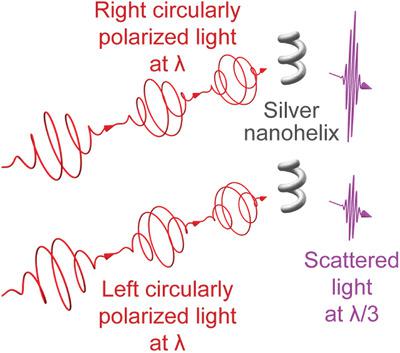当前位置:
X-MOL 学术
›
Laser Photonics Rev.
›
论文详情
Our official English website, www.x-mol.net, welcomes your
feedback! (Note: you will need to create a separate account there.)
Optical Activity in Third-Harmonic Rayleigh Scattering: A New Route for Measuring Chirality
Laser & Photonics Reviews ( IF 9.8 ) Pub Date : 2021-09-15 , DOI: 10.1002/lpor.202100235 Lukas Ohnoutek 1, 2 , Hyeon‐Ho Jeong 3, 4 , Robin Raffe Jones 1, 2 , Johannes Sachs 3 , Ben J. Olohan 1, 2 , Dora‐Maria Răsădean 5 , Gheorghe Dan Pantoş 5 , David L. Andrews 6 , Peer Fischer 3, 7 , Ventsislav K. Valev 1, 2, 8
Laser & Photonics Reviews ( IF 9.8 ) Pub Date : 2021-09-15 , DOI: 10.1002/lpor.202100235 Lukas Ohnoutek 1, 2 , Hyeon‐Ho Jeong 3, 4 , Robin Raffe Jones 1, 2 , Johannes Sachs 3 , Ben J. Olohan 1, 2 , Dora‐Maria Răsădean 5 , Gheorghe Dan Pantoş 5 , David L. Andrews 6 , Peer Fischer 3, 7 , Ventsislav K. Valev 1, 2, 8
Affiliation

|
In 3D isotropic liquids, optical third-harmonic generation is forbidden, with circularly polarized light (CPL). Yet the associated nonlinear susceptibility directly influences the optical properties at the fundamental frequency by intensity dependence (Kerr effect). Here, the hidden third-harmonic optical properties upon CPL illumination are revealed by demonstrating a new effect, in hyper-Rayleigh scattering. This effect is succinctly enunciated: the intensity of light scattered at the third-harmonic frequency of the CPL incident light depends on the chirality of the scatterers. It is referred to as third-harmonic (hyper) Rayleigh scattering optical activity (THRS OA) and was observed from Ag nanohelices randomly dispersed in water. The first analytical theory model for the new effect in nanohelices is also provided, highlighting the role of localized transition dipoles along the helical length. THRS OA is remarkably user-friendly. It offers access to intricate optical properties (hyperpolarizabilities) that have so far been more easily accessible by computation and that are essential for the understanding of light−matter interactions. The new effect could find applications in hyper-sensitive characterization of the chirality in molecules and in nanostructures; this chirality plays a fundamental role in the function of bio/nano-machinery, with promising applications in next generation technologies.
中文翻译:

三次谐波瑞利散射中的光学活性:测量手性的新途径
在 3D 各向同性液体中,禁止使用圆偏振光 (CPL) 产生光学三次谐波。然而,相关的非线性磁化率通过强度依赖性(克尔效应)直接影响基频的光学特性。在这里,通过展示超瑞利散射中的新效果,揭示了 CPL 照明下隐藏的三次谐波光学特性。这种效应简明扼要地阐明:以 CPL 入射光的三次谐波频率散射的光强度取决于散射体的手性。它被称为三次谐波(超)瑞利散射光学活性(THRS OA),是从随机分散在水中的银纳米螺旋观察到的。还提供了纳米螺旋中新效应的第一个分析理论模型,强调沿螺旋长度的局部过渡偶极子的作用。THRS OA 非常人性化。它提供了对迄今为止通过计算更容易获得的复杂光学特性(超极化率)的访问,这对于理解光-物质相互作用至关重要。这种新效应可以应用于分子和纳米结构手性的超灵敏表征;这种手性在生物/纳米机械的功能中发挥着重要作用,在下一代技术中具有广阔的应用前景。它提供了对迄今为止通过计算更容易获得的复杂光学特性(超极化率)的访问,这对于理解光-物质相互作用至关重要。这种新效应可以应用于分子和纳米结构手性的超灵敏表征;这种手性在生物/纳米机械的功能中发挥着重要作用,在下一代技术中具有广阔的应用前景。它提供了对迄今为止通过计算更容易获得的复杂光学特性(超极化率)的访问,这对于理解光-物质相互作用至关重要。这种新效应可以应用于分子和纳米结构手性的超灵敏表征;这种手性在生物/纳米机械的功能中发挥着重要作用,在下一代技术中具有广阔的应用前景。
更新日期:2021-11-11
中文翻译:

三次谐波瑞利散射中的光学活性:测量手性的新途径
在 3D 各向同性液体中,禁止使用圆偏振光 (CPL) 产生光学三次谐波。然而,相关的非线性磁化率通过强度依赖性(克尔效应)直接影响基频的光学特性。在这里,通过展示超瑞利散射中的新效果,揭示了 CPL 照明下隐藏的三次谐波光学特性。这种效应简明扼要地阐明:以 CPL 入射光的三次谐波频率散射的光强度取决于散射体的手性。它被称为三次谐波(超)瑞利散射光学活性(THRS OA),是从随机分散在水中的银纳米螺旋观察到的。还提供了纳米螺旋中新效应的第一个分析理论模型,强调沿螺旋长度的局部过渡偶极子的作用。THRS OA 非常人性化。它提供了对迄今为止通过计算更容易获得的复杂光学特性(超极化率)的访问,这对于理解光-物质相互作用至关重要。这种新效应可以应用于分子和纳米结构手性的超灵敏表征;这种手性在生物/纳米机械的功能中发挥着重要作用,在下一代技术中具有广阔的应用前景。它提供了对迄今为止通过计算更容易获得的复杂光学特性(超极化率)的访问,这对于理解光-物质相互作用至关重要。这种新效应可以应用于分子和纳米结构手性的超灵敏表征;这种手性在生物/纳米机械的功能中发挥着重要作用,在下一代技术中具有广阔的应用前景。它提供了对迄今为止通过计算更容易获得的复杂光学特性(超极化率)的访问,这对于理解光-物质相互作用至关重要。这种新效应可以应用于分子和纳米结构手性的超灵敏表征;这种手性在生物/纳米机械的功能中发挥着重要作用,在下一代技术中具有广阔的应用前景。











































 京公网安备 11010802027423号
京公网安备 11010802027423号